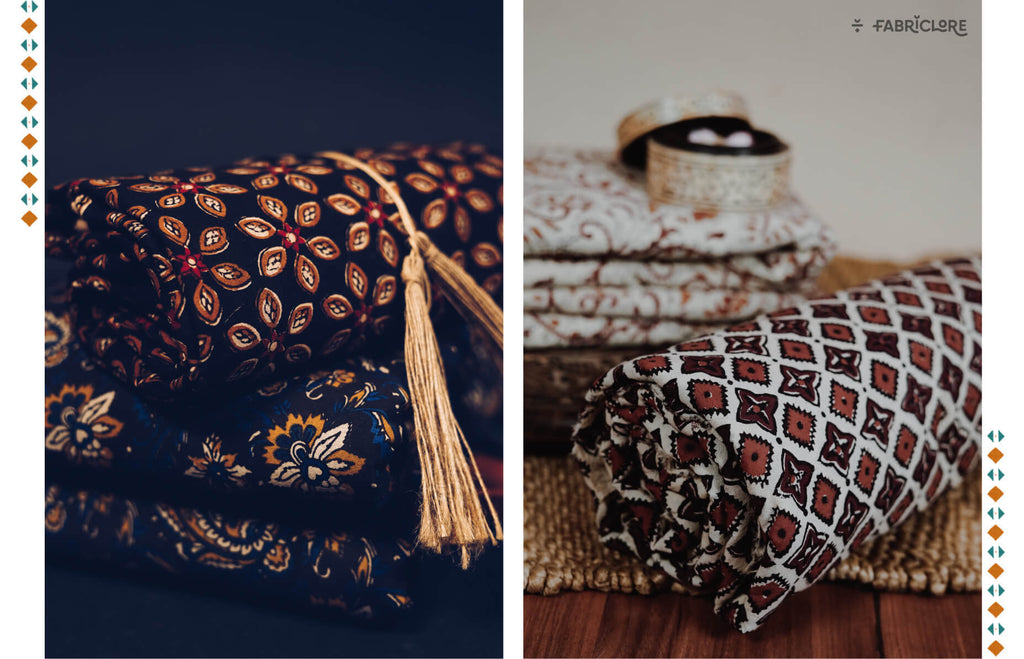“That’s the thing with handmade items. They still have the person’s mark on them. And when you hold them, you feel less alone.” – Aimee Bender
Among the traditional crafts of India which have stood similar with the evolution over time is the art of hand block printing.
Block printing is a method of printing on a fabric with the help of carved wooden pieces dipped in a dye.
The age of old art in India conveys its expression in different forms and different regions such as Kalamkari from Andhra Pradesh, Ajrakh from Gujarat, and so on. Each form of these arts has achieved perfection by skilled artisans and comprises distinct patterns and palettes.
The art of block printing has encouraged various craftsmen to develop such art under the rule of Mughals and created a number of motifs that are still used by people.
The rhythmic print of patterns and the grace of dyes, this is what adds charm to the weaving story of Dabu Print.
What is Dabu Hand Block?
Dabu (Daboo) is a traditional mud-resistant technique originating from Rajasthan. However, this practice was almost stopped in the last century but was revived later and is now a flourishing business within several districts of Rajasthan.
Even though dabu hand block print is a labor-intensive process that includes various stages of washing and printing - the result after such hard work is beautiful and unique.
Dabu print fabrics showcase an extraordinary depth to Indian culture making it famous around the globe. This style of hand block print fabric has gained recognition from well-known designers.

Who are the People Behind Dabu Hand Block?
The dabu printing is a village handicraft and has turned into a family business, where the older generation passes on their secret.
These craftsmen have a tendency to create more varieties of traditional prints which are considered the most authentic hand-printed fabric.
Whereas, the modern-day young designers are making business by selling unique Dabu printed fabrics. They learn the process from regional craftsmen and add their unique ideas.
In fact, hand-printed fabric has become a great source of inspiration for various people, and because of this, they have started producing fabrics that have ancient mud-resistant techniques.

Making of Dabu Print
The making of Dabu hand block print fabric requires a lot of effort and time. Let’s see how-
- Firstly, the fabric used for printing is soaked for around 24 hours and pre-washed to remove dirt, oil, and other contaminated particles.
- After drying the fabric, a smooth paste is prepared that contains mud, lime gum, wheat powder, and water.
- Then the wooden block is dipped into the paste and pressed onto the fabric.
- To avoid smudging the pattern, sawdust is sprinkled on top of the fabric. Later the fabric is left under sunlight to dry properly.
- For the next step, the fabric is dipped into the dye for coloring and again kept in sunlight to dry.
- Depending on the requirement, the printing and dyeing processes are repeated with different wooden blocks to give a unique design.
- Lastly, the fabric is washed and dried, and voila! This completes the making of Dabu print fabric.

Present Scenario of Dabu Print
Dabu prints fabrics have recently become popular due to their unique patterns and vibrant colors.
As earlier dabu prints were only used to design sarees however, now they are used in making all types of outfits and on every fabric like silk, georgette, etc. These fabrics are great absorbent as well as the resilient cotton fabric is most commonly used by artisans for Dabu printing.
Further, the geometric patterns and motifs have also evolved over time.
Up till now, Fabriclore has experimented with Dabu print on more than 20 types of fabrics including modal satin, chanderi, organic cotton, muslin, and so on.
So what are you waiting for? Grab our latest collection of Dabu hand block prints and design your own style.





